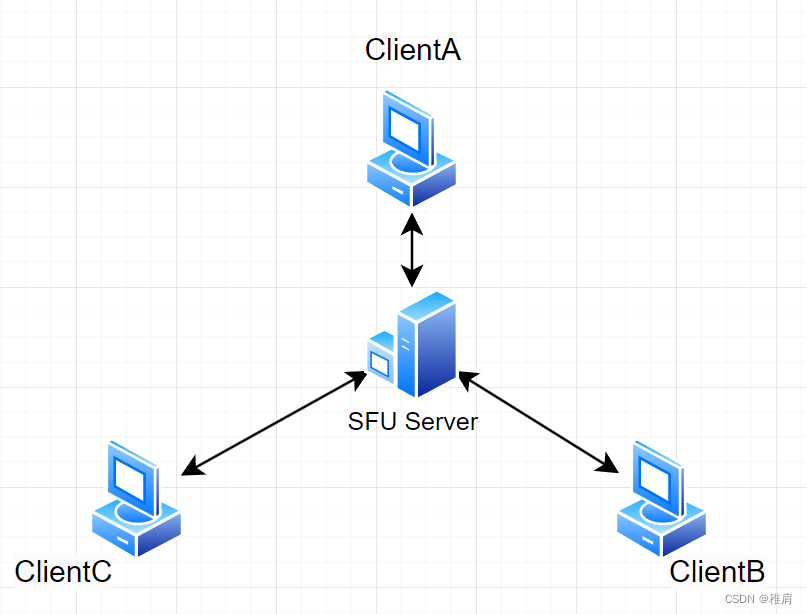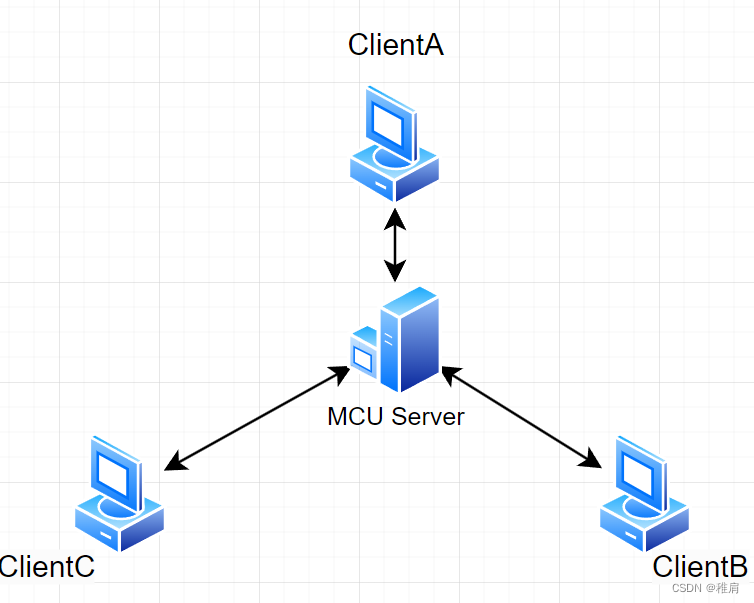WebRTC(Web Real-Time Communication)是一个开放的项目,旨在在网页端提供实时的音频、视频和数据通信,不需要插件或其他附加软件。它是由Google主导,并在Mozilla、W3C和IETF等组织的支持下开发。WebRTC的目标是使浏览器成为实时通信的强大平台,支持点对点(peer-to-peer)通信。
官方网址:https://webrtc.org/
WebRTC中文网 https://webrtc.org.cn
WebRTC官网 https://webrtc.org/
WebRTC范例 https://webrtc.github.io/samples/
WebRTC特点
实时通信: WebRTC专注于实时通信,包括音频、视频和其他数据。 WebRTC允许从设备中捕获音频和视频流,并在对等连接中传输这些流。WebRTC已经被现代浏览器(如Chrome、Firefox、Safari等)广泛支持,使得开发者能够在Web应用中集成实时通信功能。
点对点通信: WebRTC支持点对点通信,即在两个浏览器之间直接建立连接,而不需要通过中间服务器,不需要插件或其他附加软件。
多媒体引擎: WebRTC包括一个多媒体引擎,用于处理音频和视频流,提供了丰富的API和协议。
NAT穿越和防火墙遍历: WebRTC提供了一些机制,使得在NAT(Network Address Translation)和防火墙等网络设备背后进行通信更为容易。
WebRTC的网络拓扑结构
Mesh 结构

如果两个Client端能够顺利建立P2P 的连接,则直接通过 P2P 互相交换数据;如果由于网络原因,无法打通,则利用 Turn Server 来中转数据。图中的TURN Server 是指支持 TURN 协议的服务器,它扮演着一种网络中继的角色,支持把一个 Client 的数据包透明转发到多个其他的 Client 客户端。同理也可得出一对一的网络模型。
这种完全使用 P2P 方式的网络拓扑结称之为 Mesh 结构。
这种结构的优点在于逻辑简单,容易实现,较为轻量的服务端,TURN 服务器比较简单,一定比例的P2P 成功率可极大减轻服务端的压力。
缺点在于每新增一个客户端,所有的客户端都需要新增一路数据上行,客户端上行带宽占用太大。因此,通话人数越多,效果越差。
SFU通话模型

SFU 的全称是:Selective Forwarding Unit,它是一种通过服务器路由和转发 WebRTC 客户端音视频数据流的方法。
SFU 服务器将自己伪装成了一个WebRTC 的 Peer 客户端,WebRTC 的其他客户端其实并不知道自己通过 P2P 连接过去的是一台真实的客户端还是一台服务器,我们通常把这种连接称之为 P2S,即Peer to Server。
SFU服务器和TURN服务器的不同在于:
TURN 服务器仅仅是提供的一种辅助的数据转发通道,在P2P不通的时候进行透明的数据转发。而 SFU 是和客户端有业务交互的,两者是平等的关系,甚至是可以对WebRTC 客户端的数据转发的申请和控制。
MCU通话网络模型

MCU 的全称是:Multipoint Control Unit,又被称为混合,是实现多方WebRTC交流的另一种策略。
它的主要原理是由 MCU Server 将各路客户端上行的数据流合成为一路,再转发给其他客户端。这种模型相比于 SFU 降低了多人视频通话场景下客户端的下行带宽压力,但是由于合流需要转码操作,因此对服务器端压力比较大,且下发给客户端是固定的合流画面,灵活性不好。
WebRTC 实现服务端和客户端交互的代码
在 Linux 环境下使用 WebRTC 实现服务端和客户端交互的代码一般较为复杂,需要使用信令服务器进行 SDP 交换,并处理 ICE 候选等操作。下面例子是一个简化的代码,使用 WebSocket 作为信令服务器。
创建信令服务器
#include<iostream>#include<websocketpp/config/asio_no_tls.hpp>#include<websocketpp/server.hpp>#include<webrtc/api/peerconnectioninterface.h>
class WebSocketServer {
public:WebSocketServer(){
server_.init_asio();
server_.set_message_handler(bind(&WebSocketServer::OnMessage, this,::_1,::_2));
server_.set_open_handler(bind(&WebSocketServer::OnOpen, this,::_1));
server_.set_close_handler(bind(&WebSocketServer::OnClose, this,::_1));}voidRun(uint16_t port){
server_.listen(port);
server_.start_accept();
server_.run();}
private:voidOnMessage(websocketpp::connection_hdl hdl, websocketpp::server<websocketpp::config::asio>::message_ptr msg){
std::string message = msg->get_payload();// Handle incoming message (Signaling, SDP exchange, etc.)// Example: Forward the message to the appropriate WebRTC peer connection}voidOnOpen(websocketpp::connection_hdl hdl){// Handle new WebSocket connection}voidOnClose(websocketpp::connection_hdl hdl){// Handle WebSocket connection close}
websocketpp::server<websocketpp::config::asio> server_;};intmain(){
WebSocketServer ws_server;
ws_server.Run(9000);// Run WebSocket server on port 9000return0;}
客户端
#include<iostream>#include<websocketpp/config/asio_no_tls.hpp>#include<websocketpp/client.hpp>#include<webrtc/api/peerconnectioninterface.h>
class WebSocketClient {
public:WebSocketClient(){
client_.init_asio();
client_.set_message_handler(bind(&WebSocketClient::OnMessage, this,::_1,::_2));
client_.set_open_handler(bind(&WebSocketClient::OnOpen, this,::_1));
client_.set_close_handler(bind(&WebSocketClient::OnClose, this,::_1));}voidConnect(const std::string& uri){
websocketpp::lib::error_code ec;
client_.get_alog().write(websocketpp::log::alevel::app,"Connecting to "+ uri);
client_.connect(uri, ec);if(ec){
client_.get_alog().write(websocketpp::log::alevel::app,"Error connecting: "+ ec.message());}}voidSend(const std::string& message){
websocketpp::lib::error_code ec;
client_.send(hdl_, message, websocketpp::frame::opcode::text, ec);if(ec){
client_.get_alog().write(websocketpp::log::alevel::app,"Error sending message: "+ ec.message());}}
private:voidOnMessage(websocketpp::connection_hdl hdl, websocketpp::client<websocketpp::config::asio>::message_ptr msg){
std::string message = msg->get_payload();// Handle incoming message (Signaling, SDP exchange, etc.)// Example: Forward the message to the appropriate WebRTC peer connection}voidOnOpen(websocketpp::connection_hdl hdl){
client_.get_alog().write(websocketpp::log::alevel::app,"WebSocket connection opened");
hdl_ = hdl;// Perform necessary setup, e.g., create WebRTC peer connection}voidOnClose(websocketpp::connection_hdl hdl){
client_.get_alog().write(websocketpp::log::alevel::app,"WebSocket connection closed");// Perform necessary cleanup}
websocketpp::client<websocketpp::config::asio> client_;
websocketpp::connection_hdl hdl_;};intmain(){
WebSocketClient ws_client;
ws_client.Connect("ws://localhost:9000");// Connect to WebSocket server on localhost:9000
ws_client.Send("Hello, WebSocket!");// Send a message// Continue with WebRTC logic, e.g., setting up peer connection, SDP exchange, media stream control, etc.return0;}
版权归原作者 稚肩 所有, 如有侵权,请联系我们删除。